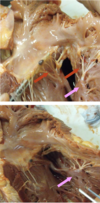Anatomy of Bloodflow Through Fetal Heart Flashcards
what are the black arrows

valve flaps of the atrio-ventricular or tricuspid valve
what are the red and pink arrows

red: chordea tendineae of tricuspid valve
pink: papillary muscles
what is the structure of the right AV (tricuspid) valve

3 cusps: chordae tendineae and papillary muscles/fibrous annular ring support

what is the action of the AV valve
passive/prevents backflow of blood into atrium at systole
1st heart sound lub = closure of right and left AV valves
what are the structures of the right ventricle


list 5 anatomical features of the right ventricle
- wall: endocardium, myocardium and epicardium
- trabecular septomarginalis: distinct feature of right atrium –> carries the short circuiting impulse to the walls –> related to the papillary muscles which will contract before the walls of the heart contract to prepare to hold the valves
- trabecular carneae: elevation of wall –> act like pectinate muscle –> dampen out the turbulence of blood
- pulmonary trunk exits RV on the left lateral side of the heart
- walls are smooth and shiny
what are the structures (transverse section through R&L ventricles)

- most cranial point
- right ventricle
- interventricular septum
- left ventricle
identify the labels and describe how blood flows through the right side

right ventricle forms the cranial margin of heart
blood exits RV through pulmonary trunk (on left lateral side) through pulmonary semi-lunar valve
pulmonary trunk bifurcates into L&R pulmonary arteries which enter root of L&R lung

list the anatomical features of the pulmonary semilunar valve

- at junction of RV and pulmonary trunk
- second heart sound ‘dub’ = closure of pulmonary and aortic semi lunar valves

what is the ligamentum arteriosum
ligament linking the pulmonary trunk and aorta
fetal remnant of the ductus arteriosus
what are these structures


describe the blood flow through the left side of the heart
- oxygenated blood enters left atrium (& auricle) from the lungs via pulmonary veins –> mitral valve (bicuspid) or left AV valve –> left ventricle –> aortic semi-lunar valve guards entrance to aorta –> aorta exits middle of base of heart
what ventricle forms the base of the heart
left –> very thick wall
what are the anatomical features of the mitral valve
2 cusps
what are the structures of left atrium and ventricle
















